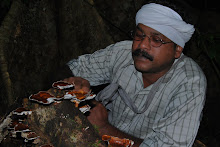
Draco: These are small forest lizards with the ability to glide from tree to tree. They have a large membrane of skin on each side supported by ribs. They have a gular(throat) pouch and lateral flaps or wattles on each side of the neck. This genus is represented by only one species in South India which is endemic to the Western Ghats

- Western ghats flying lizard (Draco dussumieri)

Sitana: They are common lizards found in the plains and forested tracts of throughout India. The body is compressed and covered over by regular keeled scales. Unlike other agamid lizards, they show the absence of a dorsal crest and in having only four toes on the hind foot. The males posses a large gular pouch. This genus is represented by a single species from India. Recent studies have revealed 3 more species of this genus from Nepal.
- Fan-throated lizard (Sitana ponticeriana)

Otocryptis: They are forest dwelling lizards confined to the forests of the western ghats and Srilanka. Thhe body is compressed with the dorsal scales keeled. They have long slender legs which allow it to run on its hind limbs when threatened. They show the absence of a tympanum and a dorsal crest. Only one species is found in India which is endemic to a few places in the Western Ghats.
- Indian Kangaroo Lizard (Otocryptis beddomii)
- Horsfield’s Spiny Lizard (Salea horsfieldi)
- Anaimalai Spiny Lizard (Salea anamallayana)
Calotes: These are typical lizards of this family found in the plains and forested regions of India. Most of them are good climbers. They have a laterally compressed body with a crest of spines on the neck and also the body in some. They have an extremely long tail. The tympanum is very conspicuous. Most of the males have a gular sac and are known to change colour during the breeding season. Seven species are known from South India of which Calotes versicolor and Calotes calotes are found throughout South India. The other five species are endemic to the Western Ghats. The recently described Calotes aurantolabium is known only from the forests of KMTR, Tamil nadu. This species was first wrongly identified as
calotes andamanensis by Ishwar and Das and it was recently redescribed as Calotes aurantolabium by Shreyas Krishnan. The species belonging to this genus in South India are
- Indian Garden Lizard (Calotes versicolor)
- Green Forest Lizard (Calotes calotes)
- Elliot’s Forest Lizard (Calotes ellioti)
- Roux’s Forest Lizard (Calotes rouxii)
- Large Scaled Forest Lizard (Calotes grandisquamis)
- Nilgiri Forest Lizard (Calotes nemoricola) and
- Calotes aurantolabium


Psammophilus: These are lizards found in hilly areas of peninsular India. They are well distinguished by their dorso-ventrally depressed body and long, slender tail. The body is covered with uniform keeled scales. They do not posses a dorsal crest. As the name suggests they are normally found in rocky habitats. There are tow species in India.
- South Indian Rock Agama (Psammophilus dorsalis)
- Dwarf Rock Agama (Psammophilus blanfordanus)




Really nice...keep up the good work...
ReplyDeletegood work.
ReplyDeletebtw whats the reference for Peltopelor macrolepis,do u have the soft copy for the revision?
canu mail it to me
Kaleshs2002in@yahoo.com